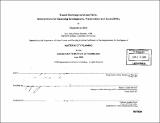Transit pathways to urban parks : interventions for balancing development, preservation and accessibility
Author(s)
Bent, Elizabeth M. (Elizabeth Mercel), 1974-
DownloadFull printable version (17.76Mb)
Other Contributors
Massachusetts Institute of Technology. Dept. of Urban Studies and Planning.
Advisor
Ralph A. Gakenheimer.
Terms of use
Metadata
Show full item recordAbstract
Getting people to parks and other green spaces is important. But most cities overlook parks as destinations in the name of density and commercial development. This thesis describes the symbiotic relationship between public transportation, open space and dense development, which together are the keys to sustainable, livable communities. Development, environmental and transit agencies together effect the creation of one of the most visible factors that influence the quality of urban life-its transportation network. The narrow focus and lack of coordination between government policies and tools also tend to lead to degradation and loss of open space, as well as access to it. Individual developers sometimes recognize the benefits of open space, but in the midst of maximizing financial returns often they depend on others to provide or require it. Years or decades later, many governments find themselves scrambling to (re)acquire open space in an attempt to improve the quality of life of their residents. Transportation improvements should continue to be used as catalysts for transforming cities and the way residents perceive them. Improvements are rare opportunities to effect change in an urban environment in a relatively short span of time. New design guidelines, incentives for developing open space, and better coordination between agencies, usually take longer periods of time to create balanced development that most people think of in the abstract. In most governmental systems responsibilities and tools are split sectorally: transit by transportation agencies, open space by environmental management or parks agencies, economic development by any number of different groups from the planning board to development agencies, etc. Rather than thinking of transportation systems as separate from environmental amenities, neighborhood amenities and economic development, planning must attempt to solidify the relationships between them to develop methods of achieving more holistic goals. This thesis contributes guidelines that will aid in developing design, policy and operational tools that facilitate coordinated, balanced accessibility to a range of uses in transit-rich urban areas, specifically open space, as it has often been neglected in the race to accessibility. This research describes the evolution of struggles between accessibility to open space and commercial development in specific urban areas, then proceeds to characterize current efforts to recreate, reacquire and reconnect open space to urban neighborhoods. It proposes a framework for interventions that prevail in these cities, and their relative success in providing accessibility. I also include a description of various implementation practices and tools, from zoning changes to coordination efforts to funding mechanisms. I conclude by applying these tools to Chicago, San Juan, Puerto Rico, and Santiago de Chile, then offering suggestions for areas where further research is needed.
Description
Thesis (M.C.P.)--Massachusetts Institute of Technology, Dept. of Urban Studies and Planning, 2003. Includes bibliographical references (p. 115-[124]).
Date issued
2003Department
Massachusetts Institute of Technology. Department of Urban Studies and PlanningPublisher
Massachusetts Institute of Technology
Keywords
Urban Studies and Planning.